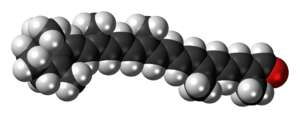Apocarotenal
Apocarotenal, or trans-β-apo-8'-carotenal, is a carotenoid found in spinach and citrus fruits. Like other carotenoids, apocarotenal plays a role as a precursor of vitamin A, even though it has 50% less pro-vitamin A activity than β-carotene. The empirical chemical formula for apocarotenal is C30H40O.
 | |
 | |
| Names | |
|---|---|
| IUPAC name
(2E,4E,6E,8E,10E,12E,14E,16E)-2,6,11,15-tetramethyl-17-(2,6,6-trimethyl-1-cyclohexenyl)heptadeca-2,4,6,8,10,12,14,16-octaenal | |
| Other names
trans-beta-apo-8'-carotenal C.I. Food Orange 6 E number 160E | |
| Identifiers | |
3D model (JSmol) |
|
| ChEBI | |
| ChemSpider | |
| ECHA InfoCard | 100.012.883 |
| E number | E160e (colours) |
PubChem CID |
|
| UNII | |
CompTox Dashboard (EPA) |
|
| |
| |
| Properties | |
| C30H40O | |
| Molar mass | 416.649 g·mol−1 |
Except where otherwise noted, data are given for materials in their standard state (at 25 °C [77 °F], 100 kPa). | |
| Infobox references | |
Apocarotenal has an orange to orange-red colour and is used in foods, pharmaceuticals and cosmetic products. Depending on the product forms, apocarotenal is used in fat based food (margarine, sauces, salad dressing), beverages, dairy products and sweets. Its E number is E160e and it is approved for usage as a food additive in the US,[1] EU[2] and Australia and New Zealand.[3]
Possible carcinogenicity
Epidemiological studies have shown that people with high β-carotene intake and high plasma levels of β-carotene have a significantly reduced risk of lung cancer. However, studies of supplementation with large doses of β-carotene in smokers have shown an increase in cancer risk, possibly because excessive β-carotene results in breakdown products that reduce plasma vitamin A and worsen the lung cell proliferation induced by smoke. The chief β-carotene breakdown product suspected of this behavior is trans-beta-apo-8'-carotenal (common apocarotenal), which has been found in one study to be mutagenic and genotoxic in cell cultures which do not respond to β-carotene itself.[4]
References
- US FDA:"Colour Additive Status List". Retrieved 2011-10-27.
- UK Food Standards Agency: "Current EU approved additives and their E Numbers". Retrieved 2011-10-27.
- Australia New Zealand Food Standards Code"Standard 1.2.4 - Labelling of ingredients". Retrieved 2011-10-27.
- Alija AJ, Bresgen N, Sommerburg O, Siems W, Eckl PM (2004). "Cytotoxic and genotoxic effects of β-carotene breakdown products on primary rat hepatocytes". Carcinogenesis. 25 (5): 827–31. doi:10.1093/carcin/bgh056. PMID 14688018.
External links
- Some info on apocarotenal
- Olson, A.J. (1964). "The biosynthesis and metabolism of carotenoids and retinol (vitamin A)" (PDF). Journal of Lipid Research. 5 (3): 281–298.